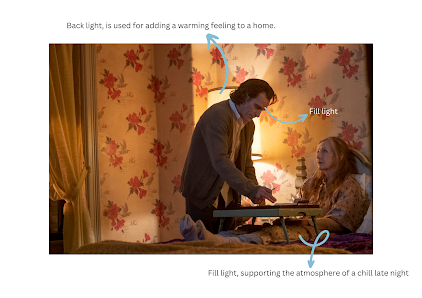★゜・。。・゜゜・。。・゜☆゜・。。・゜゜・。。・゜★
Lighting is critical in any visual medium, be it film, photography, or even video conferencing. One of the most widely used lighting conventions is the 3-point lighting technique. This technique involves using three different lights to illuminate the subject in your shot.

DEFINITION
The first light is called the key light. It is the primary light source used to light up the subject and create a sense of depth and dimension. The key light is usually placed at a 45-degree angle to the subject. The key light has a heavy influence on how a shot looks and feels. Whether or not the scene utilizes low-key, medium-key, or high-key lighting is based on the use of fill lights to expose a subject’s shadow side or side not exposed by the key light.
PURPOSE
The key light is an essential tool for cinematographers, serving as the primary source of exposure in a scene. Key light photography plays a crucial role in accurately capturing and emphasizing the shapes, dimensions, and overall mood of a subject that will be displayed on the screen. It is an indispensable technique that helps to create a visually compelling and engaging viewing experience for the audience.
WAY TO USES
 |
| For explanations, please go to: https://louisdanielbothaphotography.wordpress.com/tag/short-lighting/ |
DEFINITION
The second light used in photography is known as the backlight. Its main function is to create a separation between the subject and the background, making the subject appear more prominent. This light is usually placed behind the subject and at a higher angle.
Backlight photography can be challenging, especially if you are used to using the auto exposure modes on your camera. It’s easy to accidentally create an unpleasant exposure with a strong light behind your subject.
PURPOSE
Adding backlighting to photos can create a unique atmosphere and help to emphasize the subject. Imagine capturing a photo where the subject is highlighted with a distinct glow that sets it apart from the background. This is the magic of backlighting, a technique that adds depth and drama to your photos. The contrast created by this technique provides an eye-catching effect, and the subject becomes the focal point of the picture. By incorporating backlighting in your photography, you can add a unique and captivating element to your compositions.
DEFINITION
The third light is called the fill light. It is used to balance out the light from the key light and prevent excessive shadows on the subject's face. The fill light is usually placed on the opposite side of the key light. That, according to Studio Binder, "Among all of the film lighting techniques, the amount of fill is one of the determining factors to the mood of any lighting setup. The best cinematographers in the world have a masterful understanding of how it affects the visual style of a scene."
PURPOSE
It determines depth, contrast, and shadows; it is usually measured as a ratio comparing key light vs fill light. These light ratios determine the overall style and mood of a shot. Weaker key light will produce a higher contrast ratio with sharper shadows and deeper dark tones. This is used to create a mysterious or dramatic tone that is used in some of the best thriller movies.

In addition to the 3-point lighting technique, there are two types of light you can use in your shots: soft light, hard light, and golden hour.
Soft light is a type of lighting that is diffused, meaning it is spread out and doesn't create harsh shadows. In contrast, hard light is direct and creates sharp shadows. If you are looking to soften hard, direct light, there are several ways to do so. You can move the source of light away from the subject, which will create a larger light source and spread the light out more. Alternatively, you can place a diffuser before the light source to scatter the light and create a softer effect. Another option is to bounce the light off a wall, ceiling, or other surface to diffuse it and create a softer, more natural-looking light.
In photography and filmmaking, the golden hour is an important lighting element to consider. The golden hour refers to the period about an hour after sunrise and an hour before sunset when the sun is low in the sky. During this time, the sun creates a warm, soft light that is ideal for capturing stunning visuals. Everything seems to glow with an otherworldly radiance, making it an ideal time to take photographs or shoot videos.
★゜・。。・゜゜・。。・゜☆゜・。。・゜゜・。。・゜★
◎ JOKER (2019)
This is the movie that has been nominated for Oscar rewards four times with incredibly high scores. The audiences love this movie, despite being rated as an R for disturbing behavior, parts of Joker still reached the heart of his watcher, leaving people stunned by the true meaning behind his smiling face. That his life is not a tragedy, but, a comedy.
Top critics on Rotten Tomatoes highly recommend this movie despite having a 69% score on the website. For example, Ben Sachs in Chicago wrote:
"Joaquin Phoenix, in another outstanding performance."
Back to the movie, a lot of cinematic lighting has been used in the movie, let's go over some of the most iconic scenes and dive deeper in.
https://expertphotography.com/backlighting-photography/
https://www.studiobinder.com/blog/what-is-fill-light-photography-definition/
https://www.rottentomatoes.com/m/joker_2019
https://artlist.io/blog/backlighting/
https://louisdanielbothaphotography.wordpress.com/tag/short-lighting/
https://smiley.cool/lines.php
and some help from an ex-media student.
───── ❝ dox.xela ❞ ─────





.png)

.png)


No comments:
Post a Comment